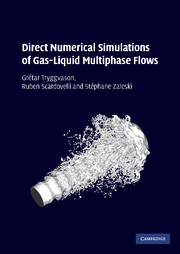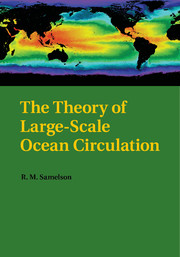3654 results in ebooks in fluid mechanics

A Voyage Through Turbulence
-
- Published online:
- 07 October 2011
- Print publication:
- 08 September 2011

Direct Numerical Simulations of Gas–Liquid Multiphase Flows
-
- Published online:
- 07 October 2011
- Print publication:
- 10 March 2011

The Theory of Large-Scale Ocean Circulation
-
- Published online:
- 07 October 2011
- Print publication:
- 27 June 2011
8 - Shock Wave???Boundary-Layer Interactions Occurring in Hypersonic Flows in the Upper Atmosphere
-
-
- Book:
- Shock Wave-Boundary-Layer Interactions
- Published online:
- 05 June 2012
- Print publication:
- 12 September 2011, pp 336-372
-
- Chapter
- Export citation
10 - Analytical Treatment of Shock Wave???Boundary-Layer Interactions
-
-
- Book:
- Shock Wave-Boundary-Layer Interactions
- Published online:
- 05 June 2012
- Print publication:
- 12 September 2011, pp 395-458
-
- Chapter
- Export citation
1 - Introduction
-
-
- Book:
- Shock Wave-Boundary-Layer Interactions
- Published online:
- 05 June 2012
- Print publication:
- 12 September 2011, pp 1-4
-
- Chapter
- Export citation
Brief Contents
-
- Book:
- Shock Wave-Boundary-Layer Interactions
- Published online:
- 05 June 2012
- Print publication:
- 12 September 2011, pp vii-viii
-
- Chapter
- Export citation
Frontmatter
-
- Book:
- Shock Wave-Boundary-Layer Interactions
- Published online:
- 05 June 2012
- Print publication:
- 12 September 2011, pp i-v
-
- Chapter
- Export citation
3 - Transonic Shock Wave???Boundary-Layer Interactions
-
-
- Book:
- Shock Wave-Boundary-Layer Interactions
- Published online:
- 05 June 2012
- Print publication:
- 12 September 2011, pp 87-136
-
- Chapter
- Export citation
6 - Experimental Studies of Shock Wave???Boundary-Layer Interactions in Hypersonic Flows
-
-
- Book:
- Shock Wave-Boundary-Layer Interactions
- Published online:
- 05 June 2012
- Print publication:
- 12 September 2011, pp 259-313
-
- Chapter
- Export citation
Index
-
- Book:
- Shock Wave-Boundary-Layer Interactions
- Published online:
- 05 June 2012
- Print publication:
- 12 September 2011, pp 459-461
-
- Chapter
- Export citation
9 - Shock-Wave Unsteadiness in Turbulent Shock Boundary-Layer Interactions
-
-
- Book:
- Shock Wave-Boundary-Layer Interactions
- Published online:
- 05 June 2012
- Print publication:
- 12 September 2011, pp 373-394
-
- Chapter
- Export citation
2 - Physical Introduction
-
-
- Book:
- Shock Wave-Boundary-Layer Interactions
- Published online:
- 05 June 2012
- Print publication:
- 12 September 2011, pp 5-86
-
- Chapter
- Export citation
Contributors
-
- Book:
- Shock Wave-Boundary-Layer Interactions
- Published online:
- 05 June 2012
- Print publication:
- 12 September 2011, pp xvii-xviii
-
- Chapter
- Export citation
5 - Ideal-Gas Shock Wave???Turbulent Boundary-Layer Interactions in Supersonic Flows and Their Modeling: Three-Dimensional Interactions
-
-
- Book:
- Shock Wave-Boundary-Layer Interactions
- Published online:
- 05 June 2012
- Print publication:
- 12 September 2011, pp 202-258
-
- Chapter
- Export citation
4 - Ideal-Gas Shock Wave???Turbulent Boundary-Layer Interactions (STBLIs) in Supersonic Flows and Their Modeling: Two-Dimensional Interactions
-
-
- Book:
- Shock Wave-Boundary-Layer Interactions
- Published online:
- 05 June 2012
- Print publication:
- 12 September 2011, pp 137-201
-
- Chapter
- Export citation
Contents
-
- Book:
- Shock Wave-Boundary-Layer Interactions
- Published online:
- 05 June 2012
- Print publication:
- 12 September 2011, pp ix-xvi
-
- Chapter
- Export citation
7 - Numerical Simulation of Hypersonic Shock Wave???Boundary-Layer Interactions
-
-
- Book:
- Shock Wave-Boundary-Layer Interactions
- Published online:
- 05 June 2012
- Print publication:
- 12 September 2011, pp 314-335
-
- Chapter
- Export citation
Contents
-
- Book:
- A Voyage Through Turbulence
- Published online:
- 07 October 2011
- Print publication:
- 08 September 2011, pp v-viii
-
- Chapter
- Export citation
2 - Prandtl and the Göttingen school
-
-
- Book:
- A Voyage Through Turbulence
- Published online:
- 07 October 2011
- Print publication:
- 08 September 2011, pp 40-100
-
- Chapter
- Export citation
